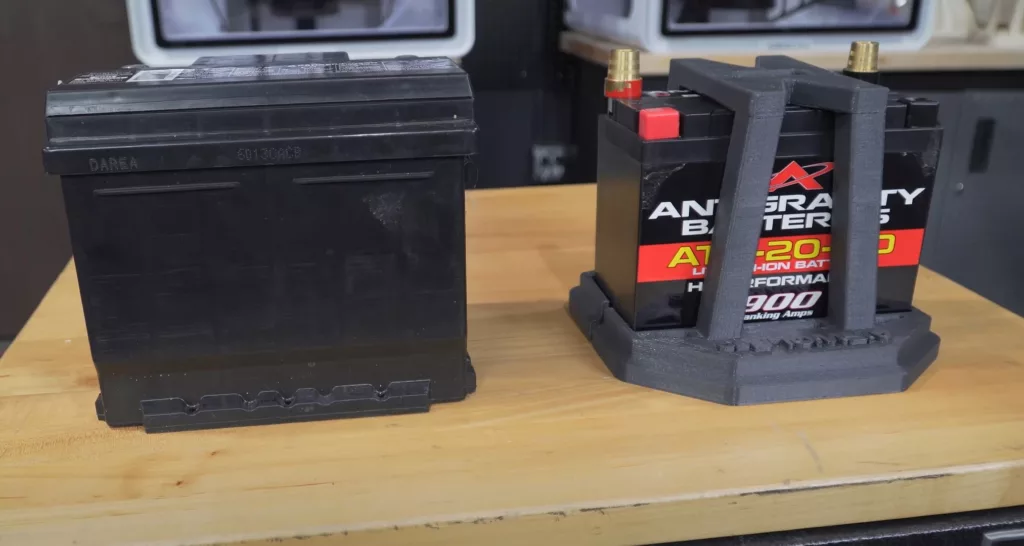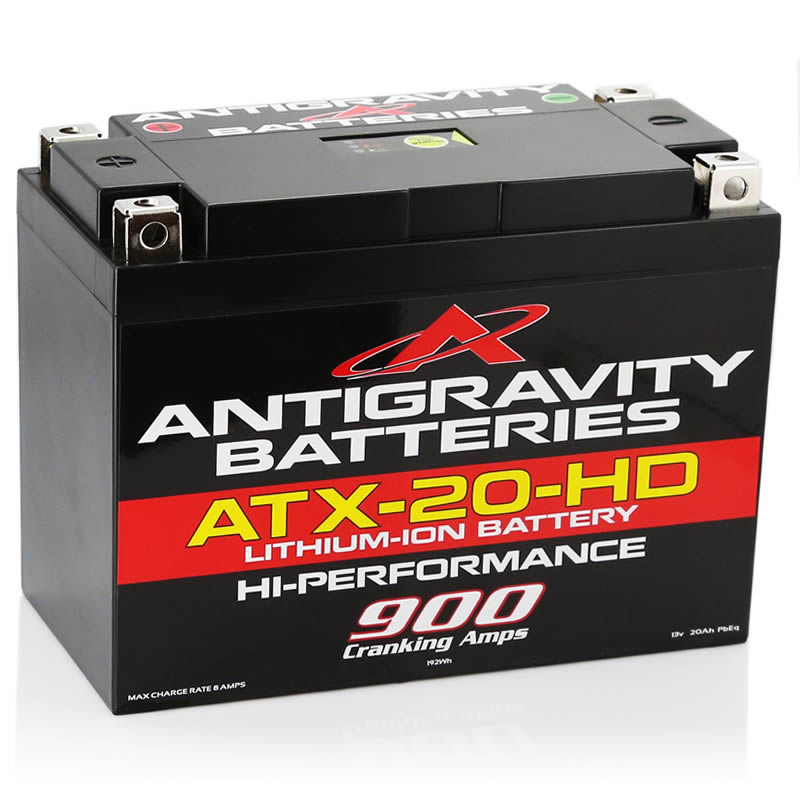Uncategorized
The Future of Automotive Power: The Lightweight Lithium Battery
We are often asked, “Is it the right time to replace the lead acid battery in my car for a lightweight lithium battery?” Lead acid batteries are widely used and well-known for their reliability, but compared to lithium-ion batteries such as the Antigravity ATX20-HD, they fall short in terms of performance and capabilities. The Antigravity ATX20-HD battery is a high-power, lightweight lithium replacement for the popular YTX-20 size lead-acid battery. Lithium-ion batteries are a high-performance energy storage alternative that can be easily implemented without the drawbacks of traditional lead-acid batteries. Therefore, lithium-ion batteries are a great choice when upgrading or replacing worn-out lead-acid batteries.
The automotive industry is at the forefront of innovation as the world shifts towards a more sustainable future. One of the most significant developments in recent years has been using lightweight lithium batteries to power electric vehicles. In this blog post, we’ll explore the benefits and drawbacks of lightweight lithium batteries in the automotive industry.
What are Lithium Batteries?
Lithium batteries are a type of rechargeable battery that use lithium as the main component in their electrochemical cells. Unlike traditional lead-acid batteries, which use a combination of lead and sulfuric acid, the Antigravity ATX20-HD lithium battery is much lighter in weight and has a higher energy density. Read more about weight differences here, “It Started With A Mustang.”

The chemical composition of lithium batteries allows them to store and release electrical energy more efficiently than lead-acid batteries. In a lithium battery, lithium ions move from the anode to the cathode through an electrolyte solution when the battery is charging, and then back again when the battery is discharging. This process is facilitated by the use of a lithium-based cathode material, such as lithium cobalt oxide or lithium iron phosphate, which allows for high energy density and high voltage.
The Antigravity ATX20-HD lithium battery is much more efficient than lead-acid batteries, with a higher energy density, faster charging times, and longer lifespan. It is also much lighter, making the ATX20-HD an ideal choice for use in racing cars, where weight is a critical factor in determining the range and performance of the vehicle.
Overall, the chemical composition of lithium batteries and their efficient electrochemical processes make them highly effective and efficient for powering all types of vehicles, from electric and hybrid vehicles to start-stop systems in traditional gasoline-powered cars.
Benefits of Using a Lightweight Lithium Battery In Your Car
While electric and hybrid vehicles are the primary beneficiaries of lightweight lithium batteries, gasoline-powered vehicles can also experience advantages by using them. Lightweight lithium batteries offer several benefits for gasoline-powered vehicles, including longer lifespan and lighter weight.
Lithium batteries’ longer lifespan means gasoline-powered vehicles can go longer between battery replacements. This reduces maintenance costs for drivers and improves the overall durability of the vehicle. Lithium batteries are also less susceptible to damage caused by deep discharging or overcharging, making them a more reliable choice for gasoline-powered vehicles.
With a lithium battery you can save 26+ pounds. The lighter weight of lithium batteries can improve the efficiency of gasoline-powered vehicles. A lighter battery reduces the overall weight of the vehicle, which can lead to better fuel economy, improved handling, and faster speed.

Overall, the advantages of using lightweight lithium batteries in gasoline-powered vehicles are clear. They offer longer lifespan and lighter weight, all of which can improve the efficiency and performance of these vehicles. As automakers continue to explore ways to reduce fuel consumption and emissions, lightweight lithium batteries are likely to play an increasingly important role in powering gasoline-powered vehicles of the future.
Challenges of Lightweight Lithium Batteries for Automotive Use
No technology is perfect, and lithium batteries come with their own set of challenges. While lithium batteries offer many advantages for vehicles, but several challenges and potential drawbacks should be considered.
One of the biggest challenges of using lithium batteries in cars is that they can be more expensive than traditional lead-acid batteries. However, as the technology becomes more widespread, the cost of lithium batteries is expected to decrease.
Safety concerns are another potential drawback of using lithium batteries. If lithium batteries are not manufactured or handled correctly, they can pose a safety risk. For example, if the battery is overcharged, it can overheat and potentially catch fire. Automakers must adhere to strict safety standards and invest in high-quality materials and manufacturing processes to mitigate these risks. It is worth mentioning that our Repop Lithium Battery Adapters are 3D printed in fire retardant material MG-94 ABS.
Additionally, there is a limited supply of the raw materials required to manufacture lithium batteries. Lithium, cobalt, and other materials used in battery production are sourced from a limited number of countries, which can lead to supply chain issues and potential geopolitical tensions. As demand for lithium batteries continues to grow, manufacturers need to explore alternative sources of these materials and develop more sustainable production methods.
As automakers continue to invest in research and development, and governments promote policies to encourage their adoption, it is likely that these challenges will be addressed and lithium batteries will become an increasingly important component of the automotive industry. In recent years, some automakers have started to offer lithium-ion starter batteries as an option in their vehicles.
Future of the Lightweight Lithium Battery in the Automotive Industry
The future of lightweight lithium batteries in the automotive industry looks promising. In addition to the current advantages of lithium batteries, there are several emerging technologies and potential advancements that could make them even more efficient and cost-effective.
One of the most promising emerging technologies is solid-state lithium batteries. These batteries use a solid electrolyte instead of the liquid or gel electrolytes found in traditional lithium batteries. Solid-state batteries have the potential to increase energy density, improve safety, and further reduce the size and weight of the battery. However, there are still several technical challenges to be addressed before solid-state batteries can be mass-produced for use in vehicles. But you may be waiting until 2028 to put a solid-state battery in your car, according to a new report in Autocar.
Another potential advancement in lithium battery technology is the use of silicon anodes. Silicon has the potential to increase energy density and reduce weight while improving overall performance. However, silicon anodes are currently more expensive than traditional anodes, and they can also degrade more quickly over time. We may be years away from having access to this replacement automotive battery and as of February 2023 there are no solid-state batteries currently powering a production car, but multiple companies have been developing the technology for a decade or longer.
There is also ongoing research into improving the sustainability of lithium batteries. Researchers are exploring ways to reduce the environmental impact of battery production and disposal, such as developing recycling processes that can recover valuable materials from used batteries.
Advancements in manufacturing processes could also make lithium batteries more efficient and cost-effective. Automakers are exploring new manufacturing techniques such as roll-to-roll processing and 3D printing to reduce the cost and improve the efficiency of battery production. Researchers in Singapore and China have even created a “quasi-solid-state” battery “made from materials somewhere between a liquid and a solid—that can be compressed by as much as 60% while maintaining high energy density and good stability over 10,000 charge–recharge cycles.” They 3-D print complex flexible structures for batteries that can stretch, squash and bend during powering.

Moreover, battery management systems (BMS) advancements could make lithium batteries even more efficient and reliable. BMS technology can monitor and control the battery’s performance and health, extending its lifespan and improving its overall efficiency. As technology continues to evolve and new advancements are made, lithium batteries will play a crucial role in reducing emissions and improving efficiency in the transportation sector.
In conclusion, lightweight lithium batteries such as the Antigravity it’s called ATX-20-HD are a promising technology that is already making a significant impact in the automotive industry. It’s benefits make it an excellent choice for powering your car. As research and development continue, we can expect to see even more advancements in various lithium battery technologies in the next 10 years that will shape the future of automotive power.


